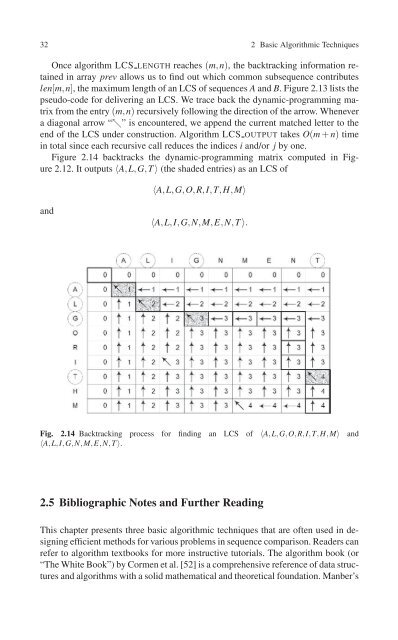You also want an ePaper? Increase the reach of your titles
YUMPU automatically turns print PDFs into web optimized ePapers that Google loves.
32 2 Basic Algorithmic Techniques<br />
Once algorithm LCS LENGTH reaches (m,n), the backtracking information retained<br />
in array prev allows us to find out which common subsequence contributes<br />
len[m,n], the maximum length of an LCS of sequences A and B. Figure 2.13 lists the<br />
pseudo-code for delivering an LCS. We trace back the dynamic-programming matrix<br />
from the entry (m,n) recursively following the direction of the arrow. Whenever<br />
a diagonal arrow “↖” is encountered, we append the current matched letter to the<br />
end of the LCS under construction. Algorithm LCS OUTPUT takes O(m + n) time<br />
in total since each recursive call reduces the indices i and/or j by one.<br />
Figure 2.14 backtracks the dynamic-programming matrix computed in Figure<br />
2.12. It outputs 〈A,L,G,T 〉 (the shaded entries) as an LCS of<br />
〈A,L,G,O,R,I,T,H,M〉<br />
and<br />
〈A,L,I,G,N,M,E,N,T 〉.<br />
Fig. 2.14 Backtracking process for finding an LCS of 〈A,L,G,O,R,I,T,H,M〉 and<br />
〈A,L,I,G,N,M,E,N,T〉.<br />
2.5 Bibliographic Notes and Further Reading<br />
This chapter presents three basic algorithmic techniques that are often used in designing<br />
efficient methods for various problems in sequence comparison. Readers can<br />
refer to algorithm textbooks for more instructive tutorials. The algorithm book (or<br />
“The White Book”) by Cormen et al. [52] is a comprehensive reference of data structures<br />
and algorithms with a solid mathematical and theoretical foundation. Manber’s

















